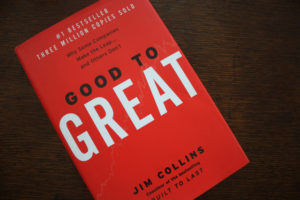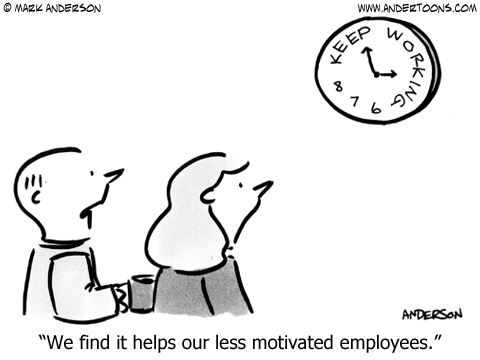When Emmanuel Osho recommended Good to Great, I was a bit skeptical about reading it because it was published in 2001 and one of the many things about books is that they tend to be outdated but since he was quite persistent I said why not.
The book has about 7 chapters of principles which I’d be sharing lazily majorly excerpts from the book and my comments on them.
Level 5 Leader
Everything rises and falls on leadership, the type of leadership required for turning a good company into a great one isn’t necessarily high-profile leaders with big personalities who make headlines and become celebrities.
The good-to-great leaders never wanted to become larger-than-life heroes. They never aspired to be put on a pedestal or become unreachable icons. They were seemingly ordinary people quietly producing extraordinary results
Comment: I’ve always known leadership is important and the book didn’t fail to highlight that.
First Who…Then What
Good-to-great leaders instead of beginning with setting a new vision or strategy, first focus on getting the right people onboard and removing the wrong people
Letting the wrong people hang around is unfair to all the right people, as they inevitably find themselves compensating for the inadequacies of the wrong people.
“No company can grow revenues consistently faster than its ability to get enough of the right people to implement that growth and still become a great company.”
The good-to-great companies made a habit of putting their best people on their best opportunities, not their biggest problems.
Comment: People, Process, Product. If you watch or have watched The profit you can relate. It’s a framework that Marcus Lemon uses to evaluate and restructure businesses. I got to see how important people are.
Confront The Brutal Facts ( Yet never lose faith)
You must maintain unwavering faith that you can and will prevail in the end, regardless of the difficulties, AND at the same time have the discipline to confront the most brutal facts of your current reality, whatever they might be.
Comment: We tend to be religious or overly optimistic about facts and that’s not wise, you can’t ignore the facts, it’s best to work with the facts to cause a change.
The Hedgehog Concept
Just because something is your core business—just because you’ve been doing it for years or perhaps even decades—does not necessarily mean you can be the best in the world at it. And if you cannot be the best in the world at your core business, then your core business absolutely cannot form the basis of a great company. Consider these 3 factors
1.What you can be the best in the world at (and, equally important, what you cannot be the best in the world at). This discerning standard goes far beyond core competence. Just because you possess a core competence doesn’t necessarily mean you can be the best in the world at it. Conversely, what you can be the best at might not even be something in which you are currently engaged.
2. What drives your economic engine. All the good-to-great companies attained piercing insight into how to most effectively generate sustained and robust cash flow and profitability. In particular, they discovered the single denominator—profit per x—that had the greatest impact on their economics. (It would be cash flow per x in the social sector.)
3. What you are deeply passionate about. The good-to-great companies focused on those activities that ignited their passion. The idea here is not to stimulate passion but to discover what makes you passionate.
Comment: You might not be the best at what you are competent at got to me, also discovering a single economic denominator for your business forces you think about what really matters.
A culture of Discipline
When you have disciplined people, you don’t need hierarchy. When you have disciplined thought, you don’t need bureaucracy. When you have disciplined action, you don’t need excessive controls.
Few successful start-ups become great companies, in large part because they respond to growth and success in the wrong way. Entrepreneurial success is fueled by creativity, imagination, bold moves into uncharted waters, and visionary zeal. As a company grows and becomes more complex, it begins to trip over its own success—too many new people, too many new customers, too many new orders, too many new products. What was once great fun becomes an unwieldy ball of disorganized stuff. Lack of planning, lack of accounting, lack of systems, and lack of hiring constraints create friction. Problems surface—with customers, with cash flow, with schedules.
In response, someone (often a board member) says, “It’s time to grow up. This place needs some professional management.” The company begins to hire MBAs and seasoned executives from blue-chip companies. Processes, procedures, checklists, and all the rest begin to sprout up like weeds. What was once an egalitarian environment gets replaced with a hierarchy. Chains of command appear for the first time. Reporting relationships become clear, and an executive class with special perks begins to appear. “We” and “they” segmentations appear—just like in a real company.
The professional managers finally rein in the mess. They create order out of chaos, but they also kill the entrepreneurial spirit. Members of the founding team begin to grumble, “This isn’t fun anymore. I used to be able to just get things done. Now I have to fill out these stupid forms and follow these stupid rules. Worst of all, I have to spend a horrendous amount of time in useless meetings.” The creative magic begins to wane as some of the most innovative people leave, disgusted by the burgeoning bureaucracy and hierarchy. The exciting start-up transforms into just another company, with nothing special to recommend it
George Rathmann avoided this entrepreneurial death spiral. He understood that the purpose of bureaucracy is to compensate for incompetence and lack of discipline—a problem that largely goes away if you have the right people in the first place. Most companies build their bureaucratic rules to manage the small percentage of wrong people on the bus, which in turn drives away the right people on the bus, which then increases the percentage of wrong people on the bus, which increases the need for more bureaucracy to compensate for incompetence and lack of discipline, which then further drives the right people away, and so forth. Rathmann also understood an alternative exists: Avoid bureaucracy and hierarchy and instead create a culture of discipline. When you put these two complementary forces together—a culture of discipline with an ethic of entrepreneurship—you get a magical alchemy of superior performance and sustained results.
It takes discipline to say “No, thank you” to big opportunities. The fact that something is a “once-in-a-lifetime opportunity” is irrelevant if it doesn’t fit within the three circles.
Comment: I think I’ve gotten too familiar with the word discipline, the breakdown of how a startup transforms to a regular company due to bureaucracy in disguise as controls finally explain a lot.
Technology Accelerators
Good-to-great companies think differently about the role of technology. They never use technology as the primary means of igniting a transformation. Yet, paradoxically, they are pioneers in the application of carefully selected technologies.
Does the technology fit directly with your Hedgehog Concept? If yes, then you need to become a pioneer in the application of that technology. If no, then ask, do you need this technology at all? If yes, then all you need is parity. (You don’t necessarily need the world’s most advanced phone system to be a great company.) If no, then the technology is irrelevant, and you can ignore it.
Mediocrity results first and foremost from management failure, not technological failure.
Throughout business history, early technology pioneers rarely prevail in the end
No technology can make you Level 5. No technology can turn the wrong people into the right people. No technology can instill the discipline to confront brutal facts of reality, nor can it instill unwavering faith. No technology can supplant the need for deep understanding of the three circles and the translation of that understanding into a simple Hedgehog Concept. No technology can create a culture of discipline. No technology can instill the simple inner belief that leaving unrealized potential on the table—letting something remain good when it can become great—is a secular sin.
How a company reacts to technological change is a good indicator of its inner drive for greatness versus mediocrity. Great companies respond with thoughtfulness and creativity, driven by a compulsion to turn unrealized potential into results; mediocre companies react and lurch about, motivated by fear of being left behind.
Comments: All my life, We always celebrate the first but then in many instances it doesn’t matter whose first if we’re to think long term, also in this era of 4th Industrial revolution, many people think finding one technological breakthrough would solve their problems or turn their businesses around, in as much as that holds some truth to an extent, transformer is deeper and bigger than technology.
The Flywheel and The Doom Loop
There was no single defining action, no grand program, no one killer innovation, no solitary lucky break, no miracle moment.
Imagine a wheel rolling fast
Now suppose someone came along and asked, “What was the one big push that caused this thing to go so fast?”
You wouldn’t be able to answer; it’s just a nonsensical question. Was it the first push? The second? The fifth? The hundredth? No! It was all of them added together in an overall accumulation of effort applied in a consistent direction. Some pushes may have been bigger than others, but any single heave—no matter how large—reflects a small fraction of the entire cumulative effect upon the flywheel.
No matter how dramatic the end result, the good-to-great transformations never happened in one fell swoop. There was no single defining action, no grand program, no one killer innovation, no solitary lucky break, no wrenching revolution. Good to great comes about by a cumulative process—step by step, action by action, decision by decision, turn by turn of the flywheel—that adds up to sustained and spectacular results.
We’ve allowed the way transitions look from the outside to drive our perception of what they must feel like to those going through them on the inside
Enduring great companies don’t exist merely to deliver returns to shareholders. Indeed, in a truly great company, profits and cash flow become like blood and water to a healthy body: They are absolutely essential for life, but they are not the very point of life.
Comments: We can’t rush greatness
WHY GREATNESS?
So you may ask like someone asked “maybe I’m just not ambitious enough,” “But I don’t really want to build a huge/great company. Is there something wrong with that?”
First, I believe that it is no harder to build something great than to build something good. It might be statistically more rare to reach greatness, but it does not require more suffering than perpetuating mediocrity. Indeed, if some of the comparison companies in our study are any indication, it involves less suffering, and perhaps even less work. The beauty and power of the research findings is that they can radically simplify our lives while increasing our effectiveness.
Indeed, the point of this entire book is not that we should “add” these findings to what we are already doing and make ourselves even more overworked. No, the point is to realize that much of what we’re doing is at best a waste of energy. If we organized the majority of our work time around applying these principles, and pretty much ignored or stopped doing everything else, our lives would be simpler and our results vastly improved.
Indeed, the real question is not, “Why greatness?” but “What work makes you feel compelled to try to create greatness?” If you have to ask the question, “Why should we try to make it great? Isn’t success enough?” then you’re probably engaged in the wrong line of work.
Perhaps your quest to be part of building something great will not fall in your business life. But find it somewhere. If not in corporate life, then perhaps in making your church great. If not there, then perhaps a nonprofit, or a community organization, or a class you teach. Get involved in something that you care so much about that you want to make it the greatest it can possibly be, not because of what you will get, but just because it can be done.
In hindsight, It’s a great book written objectively to produce principles from findings undertaking proper research for about 5–6 years. It was worth my time!
The excerpts are quite limiting, I recommend you read it if you’re interested entrepreneurship, business development/management or just a curious passerby.



